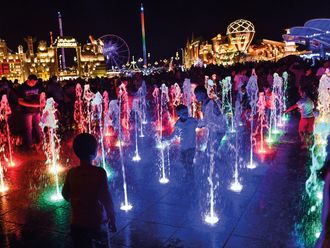High-speed jetstreams blowing over a low pressure area are the cause of the intermittent downpour that has drenched parts of the the UAE in the past three days.
Heavy rains and thunderstorms have been also reported from the remote Western Region areas and nearby islands. The Central Forecasting Office at the UAE Meteorology Department said yesterday a similar water-logged condition, combined with sand storms, would persist for the next couple of days, bringing more thundershowers and fog.
Weathermen said the current condition has been brought about by a low pressure belt over Southern Iran and the eastern part of the Arabian Peninsula. The high-speed winds, called "jet streams", above the low pressure area helped in the formation of rain brought in by heavy clouds, believed to carry ice crystals.
Waqar-ul-Waheed Khan, a meteorologist, yesterday said the jet stream has played a major role in the formation of the current weather system in the region.
"These high-speed winds normally blow at 80 knots and at 30,000 to 35,000 feet above sea level. But at this time, their speed has touched 145 knots," he said.
| A municipality worker cleans a street in Abu Dhabi. ©Gulf News |
"We have already informed the civil aviation authorities who will take necessary measures." Khan said thunder clouds were creating activity in the UAE's offshore areas till yesterday afternoon.
Skies over Al Ain and Abu Dhabi were blanketed by thick clouds yesterday. Residents welcomed the rains, though slippery roads led to six road accidents in the capital that injured seven people, some of them critically.
Major Jamal Al Ameri, Head of Public Relations and Road Safety, Abu Dhabi Traffic and Licensing Department, also blamed over speeding for the accidents.
He advised motorists to be extremely cautious and check their vehicles before starting out. He urged drivers to reduce speed and be vigilant while entering tunnels. "Drivers need to be careful driving through tunnels, bridges and highways. Most of these roads would be slippery due to oil residues, which increase the chances of accidents."
Sandy roads and highways also pose dangers to speeding vehicles, he stressed. "In the city centres, drivers need to be extra-cautious, particularly when approa-ching traffic junctions for the safety of pedestrians."
Rains started pouring from Friday night in Merawah Island, which witnessed the heaviest thundershowers in recent history.
Dr Mark Beech, an archaeologist from Abu Dhabi Islands of Archaeological Survey (ADIAS), working on an ancient site on the island, said: "We had strong torrential rains all through the night. The heaviest was between 2.00am and 3.00am when we were awakened by lightening and thunderstorms."
He said archaeological work on the site was affected as they had to stop digging yesterday morning due to heavy winds. Though rains subsidised in the afternoon, heavy winds followed.
Al Ghanadha and Al Khazna also witnessed heavy rains coupled with gusty winds.
Many parts of Dubai, Sharjah and the Northern Emirates also experienced overcast skies and light rain for much of the day yesterday, keeping the mercury down. The skies cleared towards the evening.
"March generally witnesses quite a bit of rainfall, with the average for the month being 23.8mm," said a Dubai Airport Met Office spokesperson. "So far this month, Dubai has witnessed three days of rain, yielding just over 4.5mm."
The month generally sees average maximum and minimum temperatures of 27.9°C and 17.3°C. Yesterday, the mercury ranged from 27°C to 22°C, with humidity swivelling between 80 per cent and 55 per cent.
The rains triggered some minor traffic accidents as the roads turned slippery. While some low-lying areas were water-logged briefly, most nodal traffic points held up well, ensuring smooth vehicular flow.
The Met Office predicted more passing showers today but said the weather would clear by tomorrow with a light to moderate north-easterly to easterly setting in offshore. Temperatures would rise slightly.












